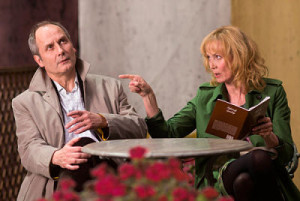STUDIO: Kino Lorber | DIRECTOR: Alain Resnais | CAST: Sabine Azema, Sandrine Kiberlain, Caroline Silhol, Andre Dussollier, Hippolyte Girardot, Michel Vuillermoz
RELEASE DATE: 3/10/15 | PRICE: DVD $24.95, Blu-ray $29.95
BONUSES: cast interviews
SPECS: NR | 108 min. | Foreign language comedy drama | 2.55:1 widescreen | 5.1 surround | French with English subtitles
In 2012 French New Wave icon Alain Resnais (Wild Grass) made a perfect “farewell” film about death, love and art entitled You Ain’t Seen Nothin’ Yet. The following year, at the age of 90, he made Life of Riley, which did actually turn out to be his farewell to the cinema (he died on March 1, 2014). Although it’s not as complex and profound as Nothin’, this stylish adaptation of a play by Alan Ayckbourn is another charming and playfully experimental work by Resnais.
All of Resnais’ works since the Eighties has been distinguished by strong ensembles — with two performers who star in Riley, Sabine Azema (The Well-Digger’s Daughter) and Andre Dussollier (Micmacs), being a steady part of the films (Azema has been in all of Resnais’ work since then; Dussollier has been in nearly all of the films). Riley offers a smaller ensemble (only six characters), but its drama and comedy rest squarely on the interplay between the performers.
The focus of the action is an unseen character named George Riley. George has been diagnosed with fatal cancer, sending his best friend (Michel Vuillermoz) and doctor (Hippolyte Girardot) into depression. Their wives (Azema, Caroline Silhol), begin to compete as to who can take better care of George, and who can bed him first. Their plans are scotched by the reappearance of his wife (Sandrine Kiberlain, The Women on the 6th Floor), who had left George for a farmer (Dussollier).
The competition between the ladies becomes the linchpin of the plot, but it’s clear that Resnais adapted Ayckbourn’s play (under the French title “Aimer, boire et chanter,” meaning “Love, drink and sing”) for the same reasons that he adapted two previous works by the playwright as Smoking/No Smoking and Private Fears in Public Places (in Riley, as in Smoking, he left the British names and locations intact in the script).
Ayckbourn’s source material quickly — in the first minute — reveals the characters to be actors (albeit of the small-town variety) who are rehearsing a play when the bombshell news about their friend is revealed. The play also includes various repetitions of actions and “doubles” — two hallmarks of Resnais’ best work.
At first glance it is indeed difficult to connect the rigorous aesthete who became internationally famous for Hiroshima Mon Amour and Last Year in Marienbad with the filmmaker who later crafted charming, smart, middle-aged (and then slightly senior) romantic comedies from the Nineties onward. However, Resnais’ approach remained essentially consistent from his first features to this last film.
He has always drawn attention to the process of image-making. Therefore, while it is indisputably a light and frothy comedy, Riley is also a realistic story he situates in an artificial environment. The characters deliver monologues against green-screen backdrops that jar the eye with stark, computer-generated b&w patterns, and their houses (which are first viewed in cartoons drawn by French artist Blutch) have painted backdrops in places of facades and front doors. Add in long shots that “reveal all” about the set, and you’re always aware that you’re watching a film.
In an essay included in this package, Resnais says that he likes to achieve “breaking down the walls between film and theater and thus ending up totally free…. I still get a kick out of bringing together things that shouldn’t meet. It’s what I call the attraction of danger, of the abyss.”
His earlier films may have contained great performances (Emmanuelle Riva in Hiroshima, John Gielgud in Providence), but the emphasis was on the visuals and the method of storytelling, which usually melded past, future and imagined events in with the present. In the films he made from the Nineties on, the spotlight has been on his impressive repertory company of actors. Riley succeeds largely because the three lead actresses are able to breathe life into their rival characters, while the male characters become more and more sympathetic and sad as their wives proclaim themselves ready to leave them for George.
It is thus fitting that the actors get the “last word” in this DVD package, as they hold forth in a video interview segment included as a supplement.
Silhol, the performer that is least known to American cinephiles, makes the most insightful statements, commenting about Resnais’ latter-day tendency toward making comedies about non-comic subjects like death, that “like painters, the older they get the lighter they paint. Same thing for some directors — the older they get the brighter they get, even when dealing with death.” She also notes that the character of Riley functions as a deus ex machina for the piece and, as a catalyst, he is also a “director,” thus Riley in a sense is Resnais himself.
Azema, Resnais’ partner for 30 years (they became a couple in the early Eighties and married in 1998) says that Resnais became “17 years old” when he was filming. She maintains that this, in turn, transformed the cast into teenagers with a “let’s put on a show together” attitude as well. While he loved theater (and cartoons and music, clearly), Azema declares he “breathes cinema.”
Like most of his best works, Riley testifies to that fact and stands as a good testament to his prodigious talent.
|
Buy or Rent Life of Riley
|
|||
|---|---|---|---|
 |
|||

Leave a Reply